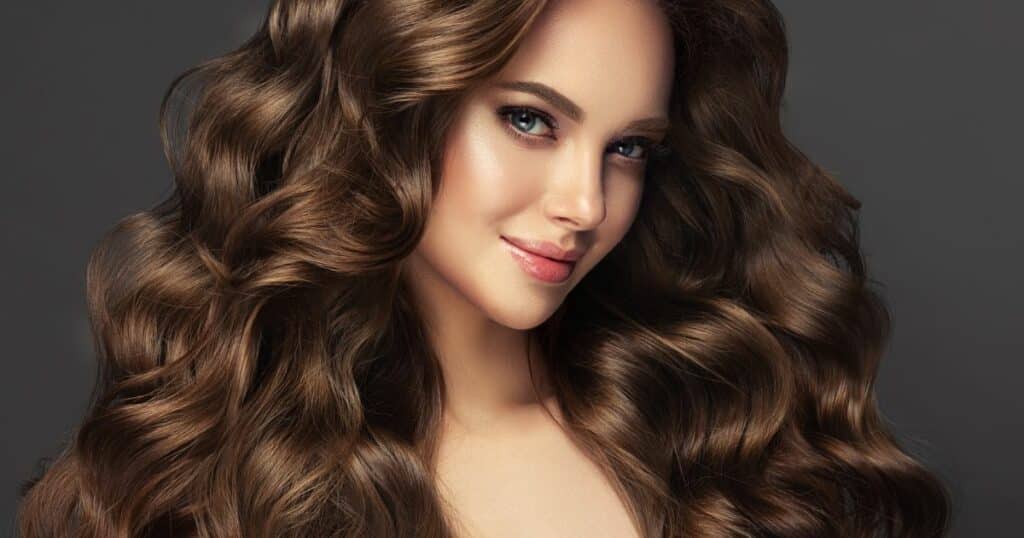Thick hair, characterized by its dense volume and individual hair strands of larger diameter, is a coveted hair type for many. While it can create a luscious, full appearance, managing and styling thick hair presents unique challenges. From determining the best products to understanding its needs, dive into the world of thick hair and explore how to make the most of this naturally voluminous asset.
Thick hair, considered a blessing by many, has unique challenges and maintenance requirements. With its luxurious appearance and full-bodied texture, thick hair can be styled in various ways to create stunning looks. However, individuals with thick hair often face difficulties managing and caring for their locks due to increased volume and a higher propensity to form knots and tangles.
Understanding the nature of thick hair is crucial for proper care and management. Maintaining scalp health, providing nourishment through a balanced diet, and practicing an appropriate hair care routine are essential to keep thick hair looking its best. Addressing hair loss, thinning, and styling challenges associated with this hair type is vital. Handling thick hair can become a breeze rather than a burden with the right knowledge and tools.
Key Takeaways
- Maintaining scalp health and proper nourishment is crucial for managing thick hair.
- Addressing hair loss, thinning, and styling challenges helps to improve hair health.
- Choosing suitable haircuts and products enhances the appearance and manageability of thick hair.
Understanding Thick Hair
Thick hair refers to the density and size of individual hair strands and the overall volume of hair on the scalp. It is essential to recognize the characteristics of thick hair to properly care for and maintain its health. Various factors, such as texture, hair type, and individual strands, can help determine if you have thick hair.
Hair texture plays a significant role in identifying thick hair. The diameter of a single hair strand can indicate the thickness of one’s hair. A thick hair strand will typically be more expansive than a standard sewing thread, while a thinner hair strand will be narrower. Thick hair can come in straight, wavy, or curly textures. Often, straight strands tend to be denser than tight curls or afro-textured hair.
Another factor influencing hair thickness is hair density, which refers to the number of hair strands per square inch of the scalp. Hair with a high density means hair follicles are closely packed together, while lower-density hair appears more spaced out. Hair density is essential when examining thick hair, as it impacts how full the hair appears and how one should care for their hair type.
Understanding your hair type to manage and style it appropriately is crucial. Different hair types have unique care requirements, and understanding the thickness of your hair can help you tailor your hair care routine accordingly. From choosing the right products to determining the ideal styling techniques, knowing your hair’s thickness can make achieving healthy, strong, and vibrant locks easier.
In summary, evaluating thick hair involves considering various factors, including texture, strand diameter, density, and hair type. These aspects are essential in understanding how to properly care for and maintain thick hair while allowing individuals to make informed decisions regarding their hair care routines.
Importance of Scalp Health
A healthy scalp is crucial for maintaining thick and strong hair. The scalp is the foundation for hair growth, containing the hair follicles responsible for producing new hair strands. Just like healthy soil is essential for robust plant growth, a well-nourished scalp ensures the well-being and thickness of hair.
One significant aspect of maintaining scalp health is to keep it clean and hydrated. A buildup of dead skin cells, sebum, and debris can clog hair follicles and lead to various issues such as dandruff, inflammation, and hair loss. Regularly cleansing the scalp and using appropriate hair care products can help create an optimal environment for hair growth.
Moisture plays a vital role in scalp health, as it helps maintain the right balance of oils and prevents dryness that can cause itching and flaking. Maintaining an adequate moisture level can be achieved by using hair care products with hydrating ingredients, avoiding excessive heat treatments, and avoiding harsh chemicals that can strip the scalp of its natural oils.
Also, proper blood circulation in the scalp is essential for hair follicles to receive the nutrients and oxygen to promote hair growth. Scalp massages stimulate blood flow, ensuring that hair follicles are well-nourished and better equipped to produce thicker and healthier hair.
In conclusion, the health of your scalp is essential in determining the thickness, growth, and overall appearance of your hair. Proper care and attention to your scalp can help you enjoy thick, luscious locks and prevent hair-related issues that can hinder your hair’s growth and vitality.
Proper Nutrition for Thick Hair
To maintain thick and healthy hair, it is essential to provide the body with the right nutrients. A balanced diet with protein, vitamins, minerals, and healthy fats will support hair health and growth.
Protein plays a crucial role in hair growth, as hair follicles mostly comprise this nutrient. Including lean meats, eggs, and dairy products in your diet can provide the necessary protein for optimal hair health.
Vitamins are vital for maintaining strong hair, particularly vitamin D, biotin, and vitamin E. Vitamin D can be sourced from fatty fish and fortified dairy products. In contrast, biotin is found in eggs, nuts, and sweet potatoes. Vitamin E, on the other hand, is abundant in nuts, seeds, and avocado.
Zinc is another essential mineral that contributes to healthy hair growth. Consuming legumes, nuts, and shellfish will help maintain adequate levels of zinc in the body, promoting hair strength and thickness.
Collagen production is necessary for maintaining the structure of hair and preventing breakage. Vitamin C-rich foods like citrus fruits and leafy greens will help the body produce collagen effectively.
Additionally, incorporating various nutrient-dense foods in your diet, such as leafy greens, whole grains, and fatty fish, will provide a mix of all the essential vitamins and minerals to promote thick and healthy hair growth. Combining these nutrient components will contribute to overall hair health, ensuring strong, lustrous locks.
Hair Care Routine for Thick Hair
Thick hair can be both a blessing and a challenge. While it gives a fuller appearance, it can also be prone to frizz, breakage, and dryness. One can manage and maintain gorgeous, thick hair by adopting a proper hair care routine. Here’s a step-by-step hair care routine specifically designed for thick hair.
Start by choosing a gentle, sulfate-free shampoo. This is important because sulfates can strip away the hair’s natural oils, leading to dryness and frizz. A sulfate-free shampoo will cleanse the hair without causing damage. Herbal Essences Aloe and Mango Sulfate-Free Shampoo is an option, but some sulfate alternatives may still be harsh for your hair type.
Next, opt for a moisturizing conditioner that will help to prevent breakage by adding hydration and nourishment to the strands. Look for conditioners specifically designed for thick hair containing ingredients like argan oil, shea butter, and keratin. These ingredients help to strengthen and smooth the hair, reducing frizz and tangles.
Incorporating a deep hair mask or treatment into the routine at least once a week is essential for managing thick, frizzy hair. Hair masks can provide additional hydration, repair damage, and promote healthier hair over time. Depending on the hair’s needs, select a hair mask that targets specific concerns, such as moisture, strength, or frizz control.
After washing and conditioning, use a leave-in conditioner or serum – especially for those who experience frizz in humid conditions. A leave-in conditioner can provide moisture and shape to the hair throughout the day. Serums, on the other hand, offer an extra layer of protection against humidity, frizz, and breakage.
Minimizing heat exposure is another crucial aspect of managing thick hair. Excessive heat can weaken the strands, leading to breakage and split-ends. Use a heat protectant before styling with hot tools and try to limit their use to special occasions or twice a week.
Lastly, investing in reliable hair care products tailored for thick hair is essential. Items like detangling brushes, microfiber towels, and silk pillowcases can significantly impact overall hair health and appearance.
In summary, a hair care routine for thick hair should include:
- A sulfate-free, gentle shampoo
- Moisturizing conditioner
- Deep hair mask or treatment
- Leave-in conditioner or serum for humidity and frizz control
- Heat protectant and limited heat styling
- Hair tools and accessories specifically designed for thick hair
Dealing with Hair Loss and Thinning
Hair loss and thinning can result from various factors, such as aging, medical conditions, and genetics. Individuals can explore different treatment options and lifestyle changes to manage these issues.
One popular medication to address hair loss is Minoxidil. This FDA-approved treatment can stimulate hair growth by increasing follicular blood flow, prolonging their growth cycle. It is typically applied topically twice daily and can yield visible results within a few months of consistent use.
In addition to using medications, a balanced diet can contribute to healthier hair. Certain vitamins and nutrients, such as protein, iron, and biotin, are essential for maintaining hair strength and growth. Some valuable sources of these nutrients include:
- Protein: lean meats, fish, beans, and legumes
- Iron: red meat, poultry, and leafy green vegetables
- Biotin: eggs, almonds, and whole grains
For those experiencing hair loss due to medical conditions, it is crucial to consult a healthcare professional to identify the root cause and develop a tailored treatment plan. Some common medical conditions that can lead to hair loss or thinning include hormonal imbalances, autoimmune disorders, and severe stress.
In summary, individuals can mitigate hair loss and manage thinning by trying medications like minoxidil, maintaining a balanced diet rich in hair-supporting nutrients, and addressing underlying medical conditions. These steps can help improve hair health and foster a more confident appearance.
Styling Tips for Thick Hair
Thick hair can be a blessing, as it often has great volume and can hold a variety of hairstyles. However, it can also be a challenge to manage and style. In this section, we will offer some styling tips for thick hair that are both practical and appealing.
When styling thick hair, finding the right tools and products for your specific needs is essential. A sturdy brush or wide-tooth comb can help detangle your hair and reduce the risk of breakage. Using a texturizing spray can also add movement and control to your locks.
Choosing the right hairstyle for thick hair can significantly affect managing its volume and shape. Short haircuts are popular for those with thick hair, as they can reduce bulk and make styling more manageable. Consider styles that complement your features if you have a particular face shape, such as oval or round. Curtain bangs can be a stylish and flattering option for thick hair, framing your face and adding dimension.
When working with curly hair, using products that enhance and control curls while reducing frizz is crucial. A curling or flat iron can be a valuable tool for taming and shaping curls, creating defined, bouncy spirals. On the other hand, a flat iron can also be used to straighten and smooth thick, curly hair for a sleek look.
For those seeking versatility in their hairstyles, thick hair can easily be transformed into updos such as a ponytail or bun. A high ponytail can add height and create an elegant, polished look, while a low bun can be a more casual and relaxed style. To add volume and height to the crown area, create a small “poof” by teasing the hair and securing it with bobby pins.
In summary, styling thick hair can be made easier by using the right tools and choosing hairstyles that match your hair type and face shape. Whether rocking curly hair, going for a short haircut, or experimenting with updos, the possibilities are plentiful for creating stylish and manageable looks. Remember to keep your hair well-hydrated and conditioned to stay healthy and beautiful.
Choosing Haircuts for Thick Hair
Stylists often recommend specific haircuts for individuals with thick hair to manage its volume, texture, and style. A suitable haircut can significantly impact the overall appearance and ease of maintenance. Here are some well-tested haircut suggestions for individuals with thick hair.
Layers and Long Layers: One popular cutting technique for thick hair is the addition of layers, especially long layers. Layers help to disperse the hair’s weight and density, leading to a more manageable and flowy look. Long layers are especially suitable for those who want a low-maintenance haircut, building movement and making the hair feel lighter without adding much upkeep.
Undercut: The undercut is an excellent option for those who wish to wear their thick hair in a shorter style. An undercut bob removes weight and bulk, avoiding the undesired bell-shaped appearance that can occur with shorter, unstructured cuts for thick hair. This haircut provides a shorter look without sacrificing style or manageability.
Pixie Cut: A pixie cut is perfect for individuals with thick hair committed to a shorter style. Depending on the specific cut, it can be styled in various ways, giving versatility and a fresh, modern appearance. Working closely with a stylist, the pixie cut can be tailored to suit the individual’s face shape and personal preferences.
Hair Thinning Techniques: To manage thick hair more efficiently, it’s essential to be aware of thinning techniques. Thinning shears, razors, and scissors can be used by professionals to decrease the hair’s density further and make it more manageable. Face-framing layers can also be incorporated into haircuts for thick hair, creating a soft, flattering shape around the face while maintaining the hair’s fullness throughout the rest.
In conclusion, when choosing thick haircuts, consider various factors such as length preference, styling ease, and compatibility with face shape. Those with thick hair can achieve a stylish and manageable look by utilizing layers, undercuts, pixie cuts, and thinning techniques. Collaborating with a hairstylist and discussing these options will help create the perfect haircut tailored to individual needs and preferences.
Product Recommendations for Thick Hair
Thick hair can benefit from specialized products that manage and enhance its natural volume and texture. This section highlights a range of products that can be useful for thick hair, including volumizing shampoos, oils, and other treatments.
Volumizing shampoos and conditioners are recommended for thick hair as they help in boosting the overall volume and fullness. A sulfate-free option like Gisou Honey Infused Hair Wash Shampoo is a great choice, as it cleanses and nourishes without stripping away the hair’s natural oils.
Natural oils are also immensely beneficial for thick hair. Castor oil, olive oil, and coconut oil provide hydration and nourishment. These oils contain essential fatty acids that strengthen and protect the hair shaft. Rosemary oil, in particular, promotes hair growth and stimulates the scalp when used with a scalp massage.
Eggs can be an effective natural remedy for those with fine or thin hair seeking more volume. Applying eggs to hair can add protein and strength, resulting in thicker, fuller-looking strands.
Another useful oil for thick hair is almond oil, which is lighter than many other oils but still serves to hydrate and improve manageability. Aloe vera and methi promote hair health and growth and can be easily found in various hair care products.
To ensure a consistent and effective hair care routine for thick hair, it is important to select products that suit your specific requirements. Choosing the right combination of volumizing shampoos, natural oils, and other nourishing treatments will help maintain healthy, manageable, and voluminous thick hair.
When Thick Hair Becomes a Problem
Thick hair may often be perceived as desirable, but those with it know that it can come with its unique set of problems. In this section, we will discuss some common issues faced by individuals with thick hair and some possible solutions to manage those challenges.
Tangles are one of the most annoying issues for people with thick hair. These knots can be complicated to remove, leading to breakage and damage. Consider using a wide-toothed comb or a specialized brush like the Tangle Teezer to minimize this issue. These tools help gently detangle hair, reducing the risk of breakage. Applying a leave-in conditioner or detangling spray can ease the combing process, making it less painful and more time-efficient.
Air-drying thick hair can be challenging, as it tends to retain moisture, leading to longer drying times. To speed up the process, using a microfiber towel or a t-shirt is recommended to squeeze out excess water after washing gently. Avoid rubbing, as it can cause friction and further tangle the hair. A hair dryer with a diffuser attachment can also be useful in reducing the air-drying time while minimizing frizz.
Those with thick hair should pay attention to the surfactants they use in their hair care routine. Surfactants are ingredients found in shampoos and other cleaning products that help remove dirt and oil. However, some surfactants can be too harsh, stripping away natural oils and leaving the hair dry and frizzy. Look for sulfate-free shampoos, which use milder surfactants, for a gentler cleansing experience.
Lastly, incorporating vitamin E into your hair care regimen is worth considering. This essential nutrient helps maintain hair health by promoting scalp circulation, supporting hair growth, and preventing breakage. Applying a vitamin E-enriched hair oil or incorporating a vitamin E supplement into your diet can help improve thick hair’s overall health and manageability.
In summary, dealing with thick hair problems may sometimes be frustrating, but proper maintenance and care can manage these issues effectively. By addressing challenges like tangles, air-drying times, choice of surfactants, and incorporating beneficial nutrients like vitamin E, those with thick hair can enjoy the benefits of their luscious locks without the drawbacks.
Frequently Asked Questions
What are the best products for thickening hair?
Numerous products are available for thickening hair, such as volumizing shampoos and conditioners, hair thickening sprays, and texturizing powders. Look for products containing ingredients such as biotin, keratin, and collagen, as these help strengthen and thicken the hair shaft. Choosing products that suit your hair type and following the instructions for optimal results is essential.
How can I naturally make my hair thicker and fuller?
Consider incorporating specific lifestyle changes and home remedies to naturally make your hair thicker and fuller. Eating a well-balanced diet rich in protein, vitamins, and minerals can promote hair growth and thickness. Some at-home treatments include egg masks, aloe vera, and coconut or olive oil massages. Additionally, avoiding excessive heat styling and harsh chemical treatments will help maintain the health of your hair and reduce breakage.
Are there any proven ways to grow thicker hair?
While there is no guaranteed method for growing thicker hair, following a healthy diet, minimizing hair damage, and using gentle hair care practices can improve hair thickness. Some hair-boosting supplements containing vitamins and minerals like biotin, vitamin D, and zinc may promote hair growth. Consult a dermatologist or trichologist to discuss your specific needs and available treatments.
What are the top thick hair shampoos?
Some top thick hair shampoos include those with volumizing and strengthening properties. Look for shampoos that contain ingredients such as biotin, keratin, hydrolyzed proteins, and panthenol. These ingredients can help improve hair strength and thickness. Remember, choosing a shampoo that suits your hair type and balances hair cleansing with maintaining your hair’s natural oils is essential.
How can women achieve thicker hair?
Women can achieve thicker hair by incorporating a healthy hair care routine, using the right products, and maintaining a well-balanced diet. Ensure the haircare products contain ingredients that promote hair thickness, such as biotin, keratin, and collagen. Limit heat styling tools and chemical treatments that can damage hair, leading to thinning and breakage. A diet rich in proteins, vitamins, and minerals also supports strong, healthy hair growth.
Is having thick hair considered attractive?
The perception of attractiveness varies among individuals and cultures. However, thick hair can signify good health and vitality, which many people find appealing. Ultimately, what matters most is that you feel confident and comfortable with your hair, regardless of its thickness or texture. Embrace your unique hair type and celebrate its beauty.






